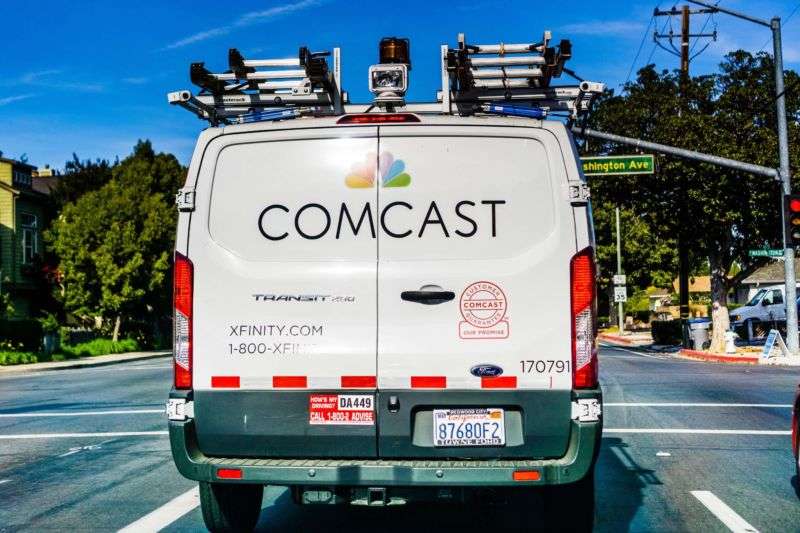
Cable companies can save money now that DOCSIS 3.1 upgrade is mostly done

Cable-company spending on network equipment is dropping as major providers like Comcast and Charter finish up their nationwide DOCSIS 3.1 rollouts.
Equipment vendors that sell to cable companies such as Arris/CommScope and Casa Systems are reporting drops in cable-related revenue. Light Reading detailed the situation this week:
Total cable access network-related revenues plummeted 38 percent in Q1 2019, to $275 million, versus the year-ago period, driven by a “strong slowdown” on capacity purchases by MSOs and an ongoing delay in deployments of new distributed access architectures, according to new data from Dell’Oro.
Cable access network spending is known to be lumpy, “but not to this extreme,” said Jeff Heynen, Dell’Oro’s research director, broadband access and home networking. He said he doesn’t recall seeing revenues in this segment of the market reach drop to such a low level since 2013.
He said the trend in reduced Q1 spending can be traced partly to Comcast and Charter Communications, which have all but wrapped up their DOCSIS 3.1 network deployments.
Charter’s first-quarter earnings announcement on April 30 said that its “decrease in scalable infrastructure spending was primarily driven by the completion of the rollout of DOCSIS 3.1 technology.” Charter, the nation’s second-largest home Internet provider after Comcast, said its capital expenditures (excluding mobile) will be $7 billion this year, down from $8.9 billion in 2018.
Comcast’s first-quarter earnings report said its cable “capital expenditures decreased 19.4 percent to $1.4 billion in Q1 2019, reflecting a lower level of spending on customer premise equipment and scalable infrastructure.” Comcast previously said it finished its DOCSIS 3.1 rollout near the end of 2018.
The upgrade to version 3.1 of DOCSIS (Data Over Cable Service Interface Specification) has helped Comcast and Charter offer gigabit-speed broadband services over standard cable wires. Cable companies will certainly continue investing in their networks and customer equipment, but cable-company suppliers are reporting spending declines.
“[T]he recent, significant declines in capital spending by certain cable providers is having a pronounced impact on Arris,” CommScope’s first-quarter earnings announcement said, referring to its subsidiary that sells DOCSIS 3.1 equipment and other network gear. ARRIS’ first-quarter revenue was $1.38 billion, a drop of 12.4 percent year-over-year.
Separately, Casa Systems CEO Jerry Guo said that Q1 2019 “was one of our toughest quarters” because of “an industry-wide slowdown” in service-provider spending on cable hardwar and “certain of our largest customers redirecting capex to other investments.”
Investment not affected by FCC deregulation
The cable-spending decline is no surprise, given that much of the cable companies’ capital spending in recent years went toward the one-time upgrade to DOCSIS 3.1. While not surprising to anyone familiar with broadband-upgrade cycles and the multi-year planning that goes into them, the cable-spending decline provides evidence against an argument frequently made by Federal Communications Commission Chairman Ajit Pai.
Pai has repeatedly claimed that his deregulatory policies are causing broadband providers to increase spending on network upgrades, bringing faster Internet speeds and more broadband connections to US customers. Pai was at it again on Monday, claiming that new data from an industry lobby group proves that he is responsible for an increase in broadband-network spending.
“The latest evidence reaffirms that our policies are working,” Pai said, attributing a spending increase to the FCC “reducing unnecessary regulatory burdens and cutting red tape that discourages broadband deployment.”
Pai didn’t mention the declines in cable-network spending. He pointed to data from USTelecom, which says that combined network spending on wireline Internet and mobile broadband increased from $72 billion in 2017 to $75 billion in 2018.
AT&T and Verizon slow investment
USTelecom attributed the increase to companies “rolling out fiber and 5G wireless,” saying that Pai’s repeal of net neutrality rules in 2017 likely spurred the rise. Pai has previously claimed that ISPs “responded to FCC reforms by deploying fiber to 5.9 million new homes in 2018, the largest number ever recorded.”
But about half of those new fiber lines came from a multi-year fiber deployment that AT&T began during the Obama administration. It was the Obama-era FCC that in 2015 required AT&T to deploy fiber to 12.5 million customer locations within four years as part of its approval of the AT&T/DirecTV merger. In other words, Pai and USTelecom are now both claiming that Pai’s deregulatory policies caused fiber deployment that was required by the FCC before Pai was the chair.
As AT&T finishes its government-mandated buildout, its fiber deployments will apparently slow down. “That’s behind us now,” AT&T Communications CEO John Donovan told FierceTelecom in an interview. “We’ll continue to invest in fiber but we’ll do it based on the incremental, economic case. We’re not running to any household target.”
AT&T’s total capital investment was $5.2 billion in Q1 2019, down from $6.1 billion in Q1 2018.
Similarly to AT&T’s multi-year fiber project, the mobile industry’s ongoing upgrade from 4G to 5G was planned years in advance and wasn’t caused by Pai’s policies. Verizon CFO Matt Ellis recently told investors that an FCC decision to prevent cities and towns from charging carriers $2 billion worth of fees would not speed up 5G deployment because Verizon is “going as fast as we can” already. Verizon’s total capital spending declined from $2.4 billion in Q1 2018 to $2.0 billion in Q1 2019.
USTelecom, even while claiming the FCC’s net neutrality repeal spurred new broadband investment, acknowledged that “many factors affect company investment decisions, such as macroeconomic conditions, technological developments, capital costs, taxes, competitive upgrade cycles, and regulation.” Publicly traded ISPs—which are legally required to provide accurate risk-factor information to investors—have admitted that the net neutrality rules didn’t harm their broadband investments.
Despite plenty of evidence that FCC policy decisions have little to no impact on broadband-network spending, and the recent discovery that his broadband-deployment data exaggerated growth, Pai this week vowed to continue stripping away regulations that broadband providers don’t want to follow. “We’ll continue on the same course—full speed ahead,” Pai said. “That means getting rid of more unnecessary regulatory burdens and updating more outdated rules so that we can continue to connect more Americans with high-speed broadband and digital opportunity.”
Disclosure: The Advance/Newhouse Partnership, which owns 13 percent of Charter, is part of Advance Publications. Advance Publications owns Condé Nast, which owns Ars Technica.




